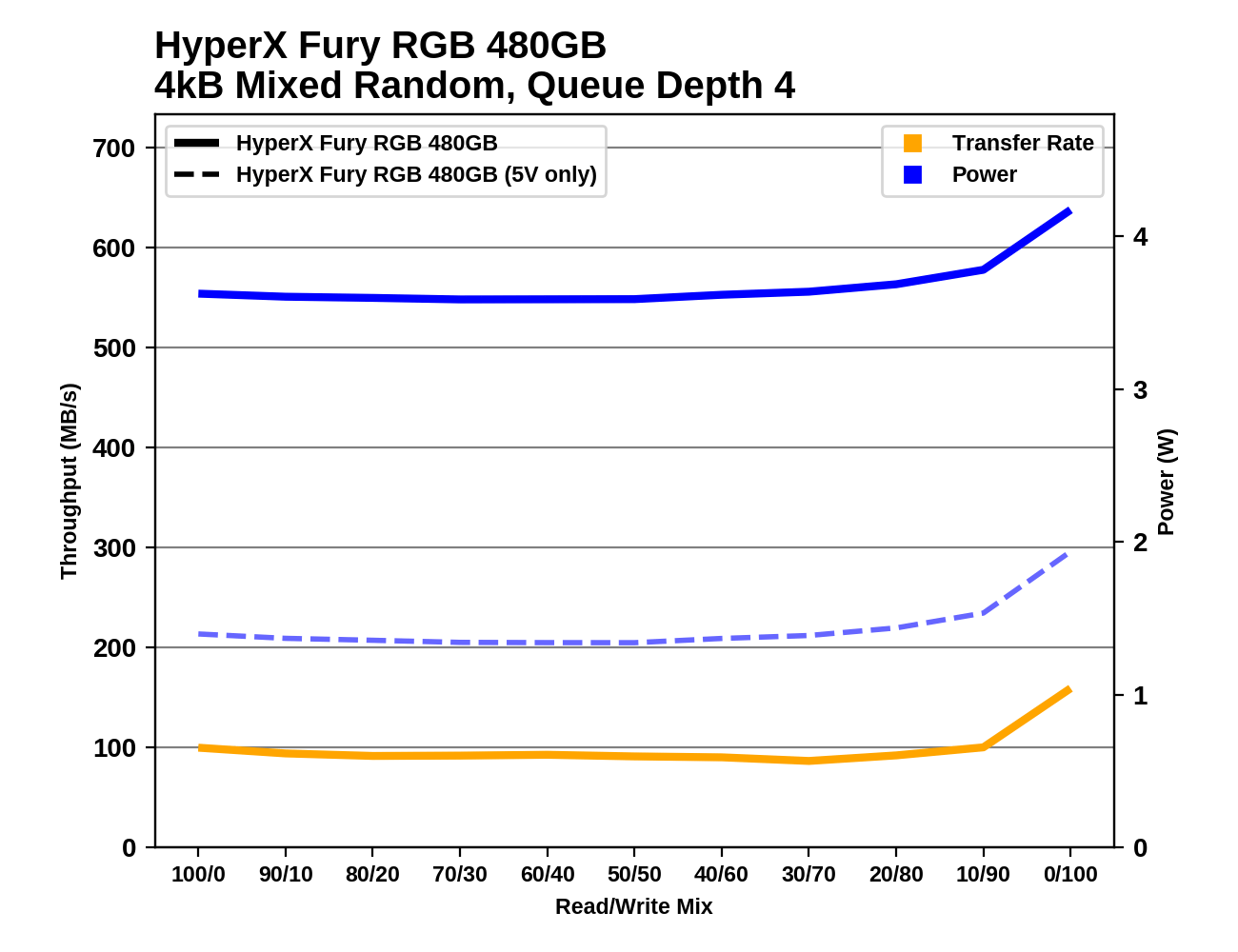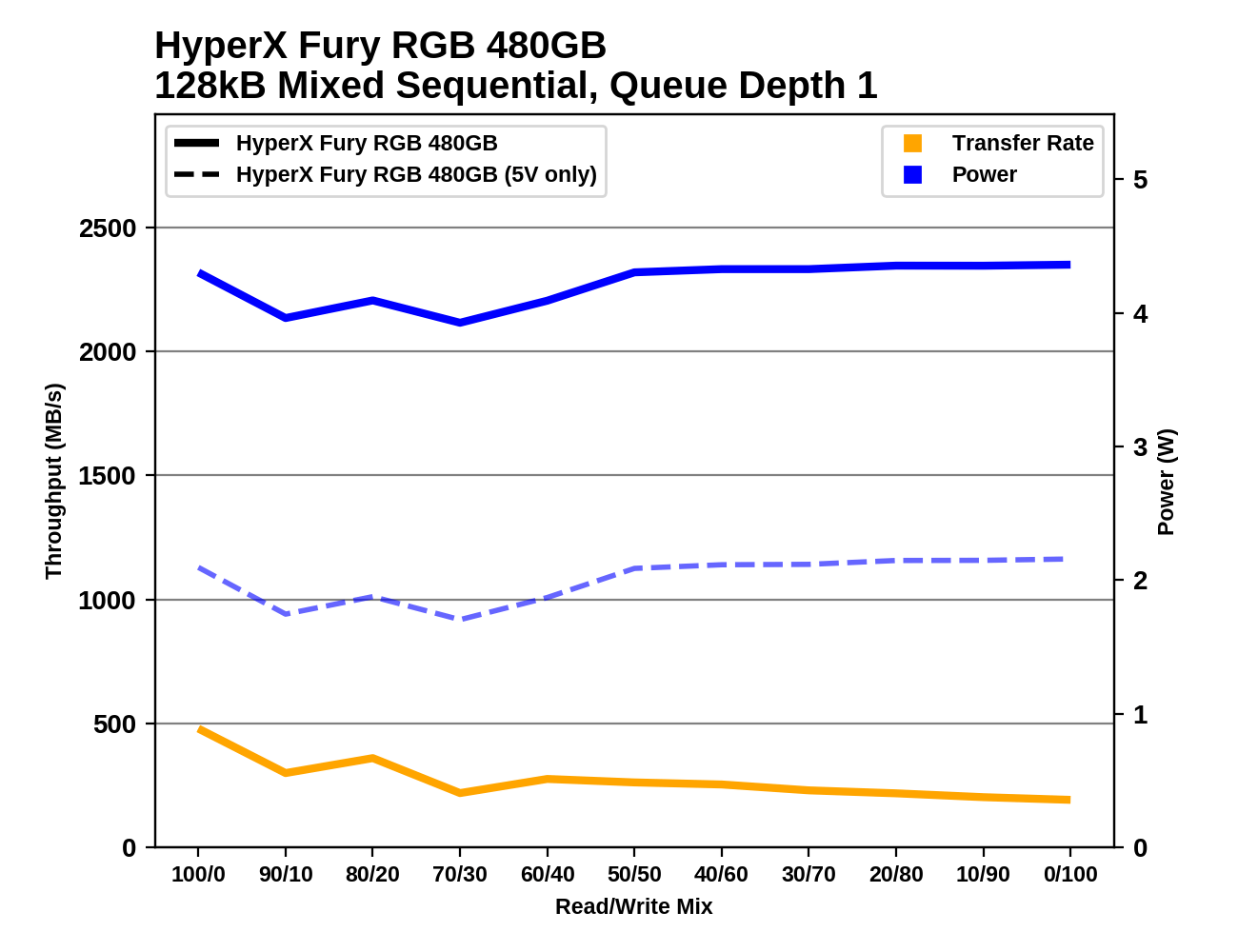The Kingston HyperX Fury RGB SSD Review: Bright Idea, Dimmed Performance
by Billy Tallis on September 24, 2018 8:35 AM ESTMixed Random Performance
Our test of mixed random reads and writes covers mixes varying from pure reads to pure writes at 10% increments. Each mix is tested for up to 1 minute or 32GB of data transferred. The test is conducted with a queue depth of 4, and is limited to a 64GB span of the drive. In between each mix, the drive is given idle time of up to one minute so that the overall duty cycle is 50%.

None of the drives in this batch that use Toshiba's BiCS3 3D TLC perform all that well on the mixed random I/O test. The Plextor M8V shows that the HyperX Fury RGB could do a bit better, but at least the Fury RGB is well ahead of the DRAMless Toshiba TR200 on this test.
 |
|||||||||
| Power Efficiency in MB/s/W | Average Power in W | ||||||||
When excluding the power used by the LEDs, the Fury RGB uses a bit less power on this test than most mainstream SATA SSDs. But the performance is low enough that the efficiency rating is still substantially lower than mainstream competition like the Crucial MX500.
 |
|||||||||
The performance and power consumption of the Fury RGB on the mixed random I/O test are both fairly steady throughout the test save for the typical jump at the end of the test when the workload shifts to pure random writes. Most mainstream drives deliver gradually increasing performance over the course of the test as the proportion of writes increases, and even some of the other BiCS3-based drives make significant gains during the last third of the test.
Mixed Sequential Performance
Our test of mixed sequential reads and writes differs from the mixed random I/O test by performing 128kB sequential accesses rather than 4kB accesses at random locations, and the sequential test is conducted at queue depth 1. The range of mixes tested is the same, and the timing and limits on data transfers are also the same as above.

On the mixed sequential I/O test we again see the HyperX Fury RGB performing like a DRAMless SSD with at least 20% lower performance than most mainstream SATA SSDs.
 |
|||||||||
| Power Efficiency in MB/s/W | Average Power in W | ||||||||
The storage side of the Fury RGB consumes the normal amount of power for a mainstream SATA SSD on this test, so ends up with a clear last-place efficiency score. The DRAMless drives that perform similarly to the Fury RGB consume much less power and have above-average efficiency.
 |
|||||||||
During the first third of the mixed sequential I/O test the performance of the HyperX Fury RGB is inconsistent. As the proportion of writes in the workload increases, the drive settles down into a gradual decline in performance that keeps it just above the Toshiba TR200.










45 Comments
View All Comments
Dragonstongue - Monday, September 24, 2018 - link
what a stupid mofo drive design...have to use a 4 pin 12v power instead of just allowing the drive to use the power that it is given etc etc..Bravo Kingston, you get a reward for one of the dumbest moves to join the RGB disco light show craze and fail miserably at it.
olafgarten - Monday, September 24, 2018 - link
It's so stupid when they put LEDs on everything.My Strix GTX980 has a white Led that can't be disabled and stays on even when the computer is shut down, I had to cover it up with tape as it was disturbing my sleep!
PeachNCream - Tuesday, September 25, 2018 - link
Strix-branded products are stupid anyway. They are part of that immature gamer-in-the-basement segment of the PC market. That doesn't justify the stupid LEDs, of course. Does your PSU have a physical switch it? You could use that or turn off power at the surge suppressor to shut the LED lights off without bothering with tape. Flipping the physical switch is a good idea anyway to reduce vampire draw from active devices to marginally reduce your electrical power bill while also cutting back on the risk of losing hardware to spikes caused by thunderstorms.MadAd - Monday, September 24, 2018 - link
woohoo, all i need now is some LED cables, an LED optical drive and some LED thermal paste and im all set!!MrSpadge - Monday, September 24, 2018 - link
> LED optical driveNope, you really want that light source to be a laser!
mobutu - Monday, September 24, 2018 - link
yuckranran - Monday, September 24, 2018 - link
So, this is like those people that buy the little Civic's or Corolla's and then pump tons of money into crazy wheels, air foils, noisy exhaust, and speaker systems that together probably cost more than the car is worth........... totally useless...Lolimaster - Monday, September 24, 2018 - link
Over 22cents per GB when better SSD's from Crucial and Samsung are jumping around 16cents per GB :Dzodiacfml - Monday, September 24, 2018 - link
Thanks for the useful title, I don't have to read the review. I clicked on your ads thoughqlum - Tuesday, September 25, 2018 - link
I feel for the poor guy who is inevitably going to put this in his laptop.